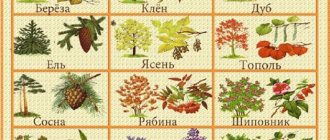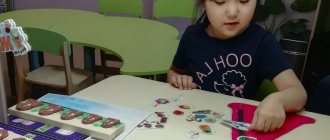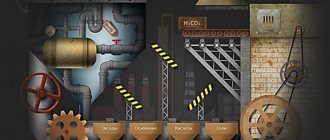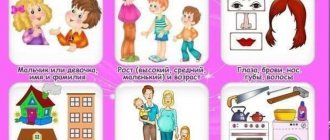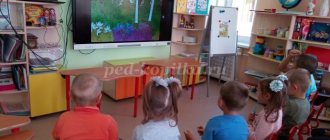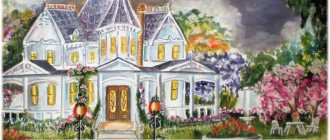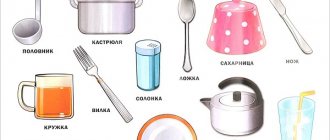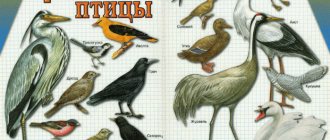“Call me kindly” - speech therapy game
Goal: improve the grammatical structure of speech.
Tasks:
- develop word formation skills;
- teach to form nouns with diminutive suffixes;
- introduce the suffixes -onok, enok, -at, yat.
- form attention.
Equipment: cards made from sheets of paper on which pictures with the image of an adult animal are drawn or glued and the same cards of a smaller size with images of the cubs of these animals.
You can simply select ready-made cards and print them out. If you plan speech therapy work with games on an ongoing basis, then it would be better to laminate these cards.
Gradually there will be a lot of cards, and it will be possible to make a whole card index out of them. Game task:
Children are divided into two teams. They are given cards with pictures of animals. One group of children is given cards with adult animals. The second group received cards with the cubs of these animals.
The game is as follows:
The speech therapist names the animal, the children show the card. The team that has the cub of this animal must quickly react, show and name this cub.
Then the teacher names the baby animal. And the card is already picked up by children who have this animal. And the team with cards of adult animals must also quickly find, show and name the corresponding adult animal.
During the game, you need to pay attention to the fact that children pronounce each name correctly.
This game can be dedicated to automating any sound or all of them at once.
For example, you can offer this version of the game to practice the sound “L”.
In this case, cards are prepared with the names of animals and cubs in which this letter appears.
Fox - little fox, fox cubs.
Leo - lion cub, lion cubs.
And here’s a quick question for you - if you play with the names of birds, how can you form a word denoting a baby/chick SWAN?
Suggest your options via the comment form.
Summary of the lesson on speech development “Tender words”
Summary of the lesson on speech development “Tender words”
Educational area:
Communication
Chapter:
Speech development
Subject:
"Sweet words"
Target:
Form ideas about word formation
Tasks:
1)
Teach to use words in diminutive form in speech
2)
Develop mobility of facial muscles.
3)
Cultivate patience, perseverance, curiosity, and the desire to finish everything to the end; arouse interest in the world around you.
vocabulary work
: affectionate
Equipment:
bear, pictograms depicting emotions
Progress:
1.Circle of joy
"Sun"
Hello, blue sky! ( raise hands)
Hello, golden sun! ( stand on tiptoes, reach for the sun)
Hello my friends! ( hold hands and form a circle)
I'm very glad to see you! ( swing arms)
Hello guys!
I'm glad to see you all today. What's your mood? ( excellent, cheerful, festive, mischievous, cheerful, sad)
2. Mimic gymnastics
Pictograms are displayed.
The teacher and children look at pictograms depicting a happy, sad, surprised, angry facial expression, and then depict the emotions on their faces.
3. Surprise moment
- Today you and I will come up with new words, and Winnie the Pooh will help us with this. Say hello!
Winnie the Pooh
: Children, do you know what this magic word means: “Hello”?
This means when we greet someone, we wish these people health. Guys, what other magic words do you know? ( children's answers
). Guys, let's play a game called “Hello!”
4.Game
"Hello"
(Children “say hello” to the part of the body that the bear cub named, repeating the movements after the teacher.)
Hello legs.
Children: Hello: (Hands on your belt, march in place, raising your knees high and extending your toes for each syllable).
Hello palms.
Children: Hello. (Clap your hands for each syllable at the same time as the words).
Hello sponges.
Children: Hello (Blow kisses to each other).
Winnie the Pooh
: Guys, I don’t know your name!!!
Maybe you can tell me? ( Yes
)
5. Game exercise
"Tender names"
The teacher encourages the children to call each other affectionately: Sashenka, Sofochka, etc.
Winnie the Pooh: Oh, well done! Eh, I would play with you, but my back hurts.
Teacher:
Children, what should you do to be healthy so that your back doesn’t hurt?
( exercise
) Let's do some physical exercise and remember one fairy tale.
6.Physical training
"Zayushkina's hut."
Our bunny lived in a hut. ( Hands above head, fingers interconnected in the form of a house
) .
He never grieved ( The head is turned in different directions
)
He sang a song cheerfully ( Nod their head
) .
And he played the pipe. ( Imitation of playing the pipe
) .
But the fox knocked. ( Knock fist on fist
) .
She drove away our hare. ( Clap their hands
) .
Now the little bunny is walking sadly. ( Spinning
.)
He doesn't find a place for himself. ( Sighs and shrugs
.)
Both the dog and the bear ( Wag their tail, then sway from side to side.)
They come up to our hare. ( Suitable for each other).
And they leave with nothing ( Separate
) .
Only a single rooster.
Helped our hare ( Hands above head, fingers connected to each other in the form of a house)
.
And now they live in the house. ( Hands above your head, fingers connected to each other in the form of a house.)
Singing in tune. ( Hugging
.)
- Guys, did you recognize the fairy tale? (“Zayushkina’s hut”)
Well done! Come on, Winnie the Pooh, how's your back? Can you play now?
Winnie the Pooh
: Yes, I feel better! Kids, I came up with a new game, would you like to play?! Only with its help you can come up with new words!
7.
Game
“I have a nose, what about you?”
The teacher names the parts of his body, and the child repeats them using the diminutive suffix.
“I have a nose,” says the teacher.
- And I have a nose.
- I have ears (and I have ears), etc.
8. Summary of the lesson
(Children name parts of the human body in a “chain”)
Winnie the Pooh: Guys, I had so much fun playing with you! You are all so smart, such affectionate guys! They also fixed my back! Do you want me to come visit again? ( Yes
) I will definitely come to you!
Goodbye ! (Children say goodbye to the guest)
Expected result
:
-know the names and locations of body parts;
-have an idea of word formation;
-be able to express your emotions, form new words
Games and exercises aimed at introducing children to each other and creating positive emotions.
Games and exercises aimed at introducing children
to each other and creating positive emotions .
Revyakina Yulia Yurievna
Affectionate name (from 5 years old).
Goals:
This exercise allows children to remember each other's names and establish contact.
Instructions.
“Remember how affectionately they call you at home. We will throw the ball to each other. And the one to whom the ball lands calls one or more of his affectionate names. In addition, it is important to remember who threw the ball to each of you. When all the children say their affectionate names, the ball will go in the opposite direction. You need to try not to mix it up and throw the ball to the one who threw it to you the first time, and in addition, say his affectionate name” [9].
.
Imagine your name in motion (from 6 years old).
Goals:
The game helps children remember the names of their comrades, evokes positive emotions and creates a sense of group unity. In this exercise, everyone gets a chance to express themselves and get attention.
Progress of the game:
children sit in a circle. Alternately, clockwise, the children make body movements that express their name. This exercise is more effective if you ask everyone to repeat names and body movements [7].
.
“Introduce yourself with a doll” (from 5 years old).
Goals:
helps relieve tension and uncertainty, allows children to get to know each other better.
Material:
two dolls of different sexes, preferably the same size as a child, or glove dolls.
Progress of the game:
The child is asked to introduce himself using a doll and tell about himself. The presenter and children can ask questions and clarify, for example: What is your favorite game? How to play it? Favorite animal? Why? The most delicious thing in the world? What do you dream about? etc. [7].
.Train (children sit in a circle) (from 5 years old).
Goals:
allows children to remember each other’s names and establish contact and be active.
Instructions.
“Today we will play trains.” At first, the engines will not have carriages, and the one we choose as the engine will “ride” alone in a circle, loudly saying “choo-choo-choo.” Then the “locomotive” gets bored and drives up to any boy or girl with the words: “little engine chuh-chuh-chuh” and says his name. The child to whom the “engine” has approached says his name in response and becomes the new engine, and the first one becomes his “car.” The new “engine”, together with the carriage, will continue to move in a circle, then drive up to any child with the words: “little train chuh-chuh-chuh” - and say his name and the name of his “car”. The game continues until all the children are included in the “train” [9].
.
Transitions (children sit in a circle) (from 6 years old ).
Goals:
The game draws attention to children’s appearance and allows them to recognize external similarities and differences.
Progress of the game:
A. The teacher asks the children to look carefully at each other: “Each of you has a different hair color. Now change places so that the one with the lightest hair is sitting on the far right, on this chair, the one with the darkest hair is sitting next to him, and the one with the darkest hair is sitting on the far right, on this chair. Let's start." An adult helps the children, approaches each of them, touches their hair, consults with the others about where to sit him, etc.
B. The task is the same as in the previous game, only the children must change places according to eye color.
Pantomime "What I Love to Do".
Goals:
forms a group and increases personal self-esteem.
Progress of the game:
Form a circle and ask the children to mime what they especially like to do. Don't make any guesses about what is being portrayed until after the pantomime is over. Everyone who wants to participate in pantomime should have this opportunity [7].
Rocket (children sitting in a circle)
Goals:
gives the child the opportunity to feel important. The game evokes positive emotions and helps relieve stress.
Instructions.
“Let's try to launch a rocket into space with an astronaut. What kind of person can be an astronaut? Of course, a brave, smart, strong person. But we are all like that here, so we will choose an astronaut using a counting rhyme. So, the astronaut takes a place in the ship - on a chair, and we will be the engine of this ship, we will squat around the chair and begin to launch the rocket.” Children first whisper “Uh-uh,” then gradually rise up, strengthening their voice, then with a loud cry of “uh,” they jump up and raise their arms up. The presenter may ask the children to repeat the launch if they were unable to jump sharply enough and shout loudly enough [9].
Game "Blind Man's Bluff" (from 5 years old).
Goals:
creating a positive emotional background, eliminating fears, increasing self-confidence.
Progress of the game:
all the children walk, dancing and singing some song, and lead the cat player blindfolded. They lead him to the door, put him on the threshold and tell him to take the handle, and then everyone together (in unison) chants: Cat, cat Pineapple, you catch us for three years! You catch us for three years! Without opening your eyes!
As soon as the last words are sung, they scatter in different directions. The cat begins to catch the players. All the children are spinning around the cat, teasing him: they either touch him with a finger, or pull his clothes [6].
Game “Bug” (from 5 years old).
Goals:
creating a positive emotional background, developing tactile sensitivity and observation.
Progress of the game:
children stand in a line behind the driver. The driver stands with his back to the group, putting his hand out from under his armpits with an open palm. The driver must guess which of the children touched his hand (by facial expression, movement). The driver leads until he guesses correctly. The driver is chosen using a counting rhyme [6].
Game “B un ” (from 5 years old).
Target:
group cohesion.
Progress of the game:
children sit on chairs. The driver walks in a circle with his eyes closed, takes turns sitting on the children's laps, and guesses who he is sitting on. If he guessed correctly, then the one he is sitting on says: “Beep” [6].
Waves (children sit in a circle) (from 4 years old).
Goals:
relieving tension, creating positive emotions. The game allows the child to feel his importance and the warm attitude of those around him.
Instructions.
“You probably love swimming in a river, a pond, but especially in the sea. Why at sea? Probably because there are usually small waves in the sea and it’s so nice when they gently wash you. Let's turn into sea waves now. Let's try to move as if we were waves. Let's try to smile like the waves when they sparkle in the bright sun. Let’s try to “rustle” like the waves when they roll over the pebbles on the shore, let’s try to say out loud what the waves would say to people swimming in them if they could speak. They would probably say, “We love you, we love you.”
Then the presenter invites everyone to take turns “swimming in the sea.” “The bather” stands and one by one they run up to him and, stroking him, quietly pronounce their words: “We love you, we love you” [9].
Kitten (children sit in a circle) (from 4 years old).
Target:
helps children express their emotions, relieve tension, and show empathy.
Instructions.
“Who wants to be given a kitten? Who has a cat at home? Imagine: mom brought home a little kitten. He is scared, it is his first time in a new house. Who can show how this kitten moves? We will now split into pairs, and one of the pair will portray such a kitten. Come out, kittens, to the center, show how scared you are in your new home. Let's start playing: let each of the children try to get to know their kitten, calm it down so that it stops being afraid. She will caress him and persuade him to sleep on the rug.” When the “kittens” fall asleep, the game ends [9].
Lost child (from 4 years old).
Goals:
develops auditory attention, promotes voice recognition.
Instructions.
“Let's imagine that we are in the forest. What are we doing there? Of course, we pick mushrooms or berries. But one of us is lost. We are very concerned and loudly and affectionately call him in turns, for example: “Hey, Sashenka!” The “lost” child stands with his back to the group and guesses who called him” [9].
Instructions:
“Guys, who likes to receive gifts? And who will give it? Who loves what more? Today we will play a game that will allow you to receive and give gifts, only imaginary ones. Let's imagine that we can give any gift to our neighbor. Look at him carefully and think about what gift he would like to receive. Now let’s take turns “giving” gifts to each other. And the one who receives the gifts does not forget to thank him.” After the children “give” each other gifts, you can ask which gift they liked best and what was more pleasant: giving or receiving gifts [9].
Baking a pie (from 4 years old).
Target:
relieving tension, learning to treat others with care, developing imagination.
Material:
blanket or blanket.
Progress of the game:
One of the children is covered with a blanket and asked to lie face down on the carpet. Then they smooth it with their hands, “sift the flour”, “roll it out”, “knead it”, “stuck in raisins” or “coat it with jam”. The “pie” is then turned over and decorated. When the “pie” is ready, he will say. Then they unwrap it, and it rises hot, like a pie coming out of the oven. The exercise is done with those who want [1].
.
Elephant on dad's back (from 3 years old).
Goals:
relieving tension, creating positive emotions, developing imagination.
Progress of the game:
all children who wish to participate in the game lie under one blanket on their stomachs and close their eyes. An adult runs one or more fingers along their backs, as if drawing the outlines of different objects. If this turns out to be difficult, you can “let different animals run” on their backs: a cat, an ant, an elephant. After all, the gait of animals is different and you can reproduce it with hand movements [2].
Friendly team
We teach children to negotiate and cooperate.
All together (from 6 years old)
Target:
develops intelligence, speed of reaction and coordination, and the ability to act in concert.
Material:
drawing crayons or sheets of newspaper.
Instructions.
It is necessary to draw a circle on the floor of such a size as to puzzle the children with a difficult but solvable problem: how they can all fit in the outlined space. To complicate the task, you can ask the children to make an “island” of newspapers that cannot be torn or moved apart.
The team that can fit into the smallest space wins [1].
.
“Send a letter” (from 6 years old).
Target:
The development of group cohesion and observation gives each child the opportunity to play the role of a leader.
Progress of the game:
children playing stand in a circle, holding hands tightly. The driver - the postman - is in the center of the circle. He says: “I am sending a letter from Seryozha to Lena.” Seryozha begins to hand over the “letter”. He shakes hands with his neighbor on the right or left, who shakes hands with the next one, and so on in a circle until the “letter” reaches Lena. The postman's goal is to “intercept” the letter, that is, to see which of the children has it. The child drives until the letter is “intercepted.” It is desirable that every child play the role of a postman [5].
Storm (from 5 years old).
Target:
develops a sense of group unity.
Progress of the game:
The leader begins the game by stopping in front of someone in the circle and rubbing his palms. The child in front of whom the leader stopped imitates the sound of a beginning storm in the same way. The leader moves further in the circle and invites each participant in front of whom he stopped to do the same. The children themselves begin to rub their hands when the leader moves around the circle a second time, snapping his fingers and inviting each participant to do the same. During the third movement along the circle, the leader makes a sound by lightly stamping his feet. The peak of the storm is indicated by full blows of the feet on the floor. Thus, at first the wind just rustled through the leaves of the trees, then the rain began, turning into downpour, and finally a real storm began. After a few seconds, the storm begins to subside. The stomping of feet gives way to light stamping, snapping of fingers, and finally rubbing of palms until there is complete silence [7].
Back to back (from 6 years old).
Target:
encourage children to analyze the communication process, realize and discuss their feelings in the process of interaction.
Progress of the game:
children sit with their backs to each other. The task is to agree on something or tell something to each other. After the exercise, children share their impressions and feelings. An adult can help them by asking questions like: “Was it comfortable for you?”, “Did you want to change anything?” It is better if the children themselves come up with a topic for conversation, but an adult can also help them with this [5].
“Confusion” (from 6 years old).
Target:
formation of group unity.
Progress of the game:
the driver is selected by a counting rhyme. He leaves the room. The rest of the children join hands and form a circle. Without unclenching their hands, they begin to get confused - as best they can. When confusion has formed, the driver enters the room and untangles them without unclenching the children’s hands [b].
“Palm on palm” (from 5 years old).
Target:
development of the ability to coordinate actions with a partner.
Progress of the game:
children press their palms against each other and thus move around the room, where you can set up various obstacles that the couple must overcome. This could be a chair or a table, or it could be a mountain or river built by a child. An adult-child pair can participate in the game [5].
“Changing buttons” (from 5 years old).
Target:
encourages children to negotiate with each other and cooperate.
Material:
100 buttons of 10 in different colors, templates with colored patterns.
Progress of the game:
The presenter mixes the buttons and then gives each participant a template and 10 buttons (the number of buttons is determined by the number of participants). Each child must assemble a pattern of a certain color from buttons according to a template. To do this, he will have to exchange buttons with other children.
Games to relieve stress.
“Rwaklya” (sZlet).
Goals:
Helps relieve tension and provides an outlet for destructive energy.
Material:
unnecessary newspapers, magazines, papers; wide bucket or basket.
Progress of the game:
a child can tear, crumple, trample the paper, do whatever he wants with it, and then throw it into the basket. A child may like to jump on a pile of pieces of paper - they have great spring [8].
Zoo (from 5 years old).
Target:
helps relieve tension.
Progress of the game:
children “turn” into animals, into those they want to become. First, everyone sits on chairs (“in cages”). Each child portrays his own animal, the others guess who he is portraying. After everyone has been “recognized,” the cages open and the “animals” are released: they jump, run, growl, and scream [5].
“Bear cubs” (from 4 years old).
Target:
The exercise is aimed at muscle relaxation.
Progress of the game:
the child turned into a little bear cub. He lies in the den. A cold wind blew and made its way into the den. The bear cub is frozen. He's curled up into a small ball, warming himself. It got hot, the bear cub turned around and growled.
The adult tells the child about the bear cub, and the child imitates its movements [5].
From seed
to tree (from 4 years old).
Target:
training in expressive movements, relaxation.
Progress of the game:
children stand in a circle. The teacher stands in the center and invites the children to turn into a small wrinkled seed (shrink into a ball on the floor, remove their head and cover it with their hands). An adult - a gardener - treats the seeds very carefully, waters them (strokes them on the head and body), and takes care of them. With the warm spring sun, the seed begins to grow slowly (children-seeds slowly rise). Its leaves open (arms rise), a stem grows (the body stretches), branches with buds appear (arms to the sides, fingers clenched). A joyful moment comes - the buds burst (the fists unclench sharply), and the sprout turns into a beautiful strong flower. Summer comes, the flower becomes prettier, admires itself (examine itself), smiles at the neighboring flowers, bows to them, lightly touches them with its petals (reach the neighbors with your fingertips). But then the wind blew, autumn came. The flower swings in different directions, fights the weather (swinging with arms, head, body), bends, bends towards the ground and lies on it. He's sad. But then the winter snow began to fall. The flower again turned into a small seed (curl up on the floor). The snow has covered the seed, it is warm and calm. Soon spring will come again, and it will come to life. The teacher walks between the children, shows them the movements. After the children “curl up” on the floor, an adult approaches each child and strokes him.
Magic transformations.
Goals:
give the child the opportunity to relieve tension and show aggression, gradually reducing them to nothing. The game teaches children to correlate their actions with instructions and control activity.
Progress of the game:
the adult pronounces the text; to enhance the effect, you can show the children a picture depicting the image into which they will turn. For example: “Imagine that you have turned into brave lions. You are strong and fearless. All the animals in the area tremble from your roar. Now you are hungry and go hunting. (Children can move like lions, roar, sharpen their claws, etc.) In order not to scare away the prey, you slowly sneak through the thickets and sniff. But what is this noise? You lie down on your stomach and wait. The noise gets closer and you can clearly hear dogs barking and human voices. And also - shots! (You can make some loud noise or puncture a balloon.) It's time to save yourself! Quickly run to your lair! (The children each run to their own “den.”) Finally, you are home! You can catch your breath and take a few deep breaths in and out. And then you curl up like a house cat and close your eyes - you need to rest a little.” After a while, the presenter asks the children to open their eyes, stretch sweetly and asks: “Are you rested? Now turn into boys and girls again.”
Depending on the characteristics of the children's group, you can come up with any text.
There is a warm-up with movements at the discretion of the leader.
♦ One, two, three, four, five! Let's play with the rain: Rain, rain, come! Rain, rain, go away! Rain, rain, squat, Rain, rain, fly away. Rain, rain, calm down, Rain, rain, go to sleep...
Didactic games for the formation of grammatical structure of speech. Theme "Autumn"
Didactic games on the topic: “Sorceress Autumn”
Prepared by speech therapist teacher: Kovaleva A.V.
Senior group.
Training tasks:
- Clarify, expand and consolidate children's knowledge about autumn and its signs.
- Develop the ability to form nouns using diminutive suffixes.
- Form possessive adjectives.
- Agree nouns and adjectives.
- Develop the ability to compose sentences from deformed text.
Developmental tasks:
- Develop the ability to establish cause-and-effect relationships and accompany practical actions with speech.
Educational tasks:
- Cultivate interest in classes, foster a culture of communication, and the ability to listen to the answers of your comrades.
- Cultivate a love for nature.
Corrective tasks:
- Eliminating ungrammatical use of words in the structure of a simple sentence.
DIDACTIC GAMES
Game “Name it kindly”
(Formation of nouns with diminutive suffixes)
Rain - rain, little rain, sun - sun, puddle - puddle, tree - tree, wind - breeze, leaf - leaf, leaf, leaf, cloud - cloud, forest - forest, garden - garden, bird - bird.
Game “One - Many”
(Formation of the plural of nouns in the genitive case)
Month - months, tree - trees, rain - rains, fruit - fruits, puddle - puddles, vegetable - vegetables, harvest - harvests, leaves - leaves, garden - gardens, bird - birds, vegetable garden - vegetable gardens, slush - slush, umbrella - umbrellas, forest - forests.
Game “Say with the word “autumn”” (Agreement of noun and adjective)
The sky (which one?) is autumnal, the wind (which one?) is autumnal, the alley (which one?) is autumnal. The exercise is continued with the words: sun, cloud, rain, flowers, forest, weather, boots, day, morning, coat. Game "Name What's the Weather?"
(Formation of qualitative adjectives)
What is the weather like in autumn if it rains? - rainy, ... the wind is blowing - windy; If it's cold outside, what's the weather like? - cold; if it’s cloudy - cloudy, ... damp - damp, ... gloomy - gloomy, ... sunny - sunny, ... clear - clear. Game “One - Many”
(Formation of the plural of verbs, nouns and adjectives)
An autumn day has arrived - autumn days have arrived, there is a yellow leaf on the tree - there are yellow leaves on the trees, a dark cloud is floating - dark clouds are floating, there is a big tree - there are large trees, there is cold rain - there are cold rains, a strong wind is blowing - strong winds are blowing, a warm jacket is hanging - warm jackets are hanging, a flock of birds is flying - flocks of birds are flying. Game “Say the opposite”
(Search for antonyms)
Early autumn - late autumn, happy day - sad day, sunny day - cloudy day, white cloud - black cloud, ... cold - hot, ... good - bad.
Game “I’ll start, and you finish”
(Search for the corresponding concept)
People are dressed in autumn, (what?) - ...; schoolchildren go with their briefcases (where?) - ...; the leaves on the trees have become (what?) - ...; flowers in the flower beds (what did they do?) - ...; birds fly away (where?) - ...; animals do for the winter (what?) - ...; people collect in forests, gardens, fields and vegetable gardens (what?) - .... Construction of the monologue “Tell me about autumn according to plan”:
1) when autumn comes;
2) autumn months; 3) signs of autumn in nature; 4) the beauty of golden autumn; 5) what birds and animals do in the fall; 6) human labor in the autumn period; 7) autumn clothes. Game “Correct the Errors”
(Search for factual errors)
Summer has passed and autumn has come. Cold winds blew, flowers withered, leaves blossomed on the trees. The animals began to make provisions for the winter: the hedgehog - honey, the squirrel - nuts, the bear - cabbage, the fox - apples. Birds flew in from the south. The children put on their Panama hats and went out for a walk in the yard. They played hide and seek, made a snowman and fed crumbs to the birds.
